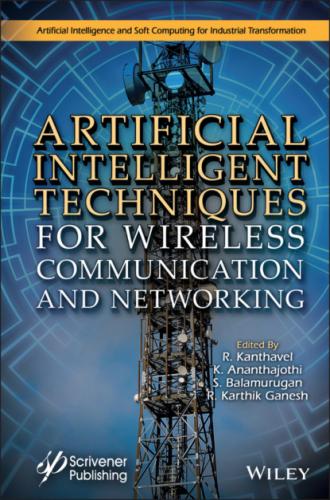Library of Congress Cataloging-in-Publication Data
ISBN 978-1-119-82127-4
Cover image: Pixabay.Com
Cover design by Russell Richardson
Set in size of 11pt and Minion Pro by Manila Typesetting Company, Makati, Philippines
Printed in the USA
10 9 8 7 6 5 4 3 2 1
Preface
In the current digital era, artificial intelligence (AI) resembling human intelligence is enabling superior inventions for the advancement of the world. Broadening the scientific scope of AI has made it possible to change fundamentals and modulate everlasting facts in the wireless communication and networking domains. This breakthrough in AI miraculously preserves the inspired vision of communication technology.
Wireless communication and networking based on AI concepts and techniques are explored in this book, specifically focusing on the current research in the field by highlighting empirical results along with theoretical concepts. The possibility of applying AI mechanisms towards security aspects in the communication domain is also elaborated. Moreover, the application side of integrated technologies are also explored to enhance AI Revolution innovations, insights, intelligent predictions, cost optimization, inventory management, identification processes, classification mechanisms, cooperative spectrum sensing techniques, ad-hoc network architecture, and protocol and simulation-based environments.
This book allows both practitioners and researchers to share their opinions and recent research on the convergence of these technologies with those in academia and industry. The contributors have presented their technical evaluation and comparative analysis of existing technologies; and theoretical explanations and experimental case studies related to real-time scenarios are also included. Furthermore, this book will connect IT professionals, researchers, and academicians working on 5G communication and networking technologies.
The book is organized into 20 chapters that address AI principles and techniques used in wireless communication and networking. It outlines the benefits, functions, and future role of AI in wireless communication and networking. In addition, AI applications are addressed from a variety of aspects, including basic principles and prominent methodologies that offer researchers relevant instructions to follow in their research. The editing team and expert reviewers in various disciplines have thoroughly reviewed the information included.
– In Chapter 1, “Comprehensive and Self-Contained Introduction to Deep Reinforcement Learning,” P. Anbalagan, S. Saravanan and R. Saminathan present a brief guide to the deep reinforcement learning process and its detailed applications and research directions in order to enhance the basics of reinforcement mechanisms.
– In Chapter 2, “Impact of AI in 5G Wireless Technologies and Communication Systems,” A. Sivasundari and K. Ananthajothi present an in-depth overview of the implementation of AI to improve 5G wireless communication systems, discuss the role and difficulties faced, and highlight suggestions for future studies on integrating advanced AI into 5G wireless communications.
– In Chapter 3, “Artificial Intelligence Revolution in Logistics and Supply Chain Management,” P.J. Satish Kumar, Ratna Kamala Petla, Elangovan K and P.G. Kuppusamy give a brief description of recent developments and some relevant impacts concerning logistics and supply chain related to AI.
– In Chapter 4, “An Empirical Study of Crop Yield Prediction Using Reinforcement Learning,” M. P. Vaishnnave and R. Manivannan use reinforcement learning (RL) data technologies and high-performance computing to create new possibilities to activate, calculate, and recognize the agricultural crop forecast.
– In Chapter 5, “Cost Optimization for Inventory Management in Blockchain Under Cloud,” C. Govindasamy, A. Antonidoss and A. Pandiaraj investigate some of the most prominent bases of blockchain for inventory management of blockchain and cost optimization methods for inventory management in cloud.
– In Chapter 6, “Review of Deep Learning Architectures Used for Identification and Classification of Plant Leaf Diseases,” G. Gangadevi and C. Jayakumar describe the deep learning architectures for plant disease prediction and classification using standard techniques like artificial neural network (ANN), k-means classifier (K-means), recurrent neural network (RNN), k-nearest neighbor (K-NN) classifier, and support vector machine (SVM).
– In Chapter 7, “Generating Art and Music Using Deep Neural Networks,” A. Pandiaraj, Lakshmana Prakash, R. Gopal and P. Rajesh Kanna develop a model using deep neural nets that can imagine like humans and generate art and music of their own. This model can also be used to increase cognitive efficiency in AGI (artificial general intelligence), thereby improving the agent’s image classification and object localization.
– In Chapter 8, “Deep Learning Era for Future 6G Wireless Communications – Theory, Applications, and Challenges,” S. K. B. Sangeetha, R. Dhaya, S. Gayathri, K. Kamala and S. Divya Keerthi encapsulate the background of 6G wireless communication with details on how deep learning has made a contribution to 6G wireless technology and also highlight future research directions for deep learning-driven wireless technology.
– In Chapter 9, “Robust Cooperative Spectrum Sensing Techniques for a Practical Framework Employing Cognitive Radios in 5G Networks,” J. Banumathi, S.K B. Sangeetha and R. Dhaya discuss the use of cooperative spectrum sensing in cognitive radio systems to improve the efficiency of detecting primary users.
– In Chapter 10, “Natural Language Processing,” S. Meera and B. Persis Urban Ivy elucidate natural language processing (NLP), which is a branch of computer science and artificial intelligence that studies how computers and humans communicate in natural language, with the aim of computers understanding language as well as humans do.
– In Chapter 11, “Class-Level Multi-Feature Semantic Similarity-Based Efficient Multimedia Big Data Retrieval,” Sujatha D, Subramaniam M and A. Kathirvel present an efficient class-level multi-feature semantic similarity measure-based approach. The proposed method receives the input query and estimates class-level information similarity, class-level texture similarity, and class-level semantic similarity measures for different classes.
